BATON PASSEPISODE 02
OUR ASPIRATIONS FOR AIR CARGO
Cargo compartments are located below the passenger deck floor of an aircraft for loading cargo and mail as well as baggage checked in by passengers at the airport.
Taking advantage of the benefit of speed provided by air transport, all kinds of goods are transported by air, such as electronic parts, automobile parts, garments, perishables, agricultural products, live flowers and pharmaceuticals.
Cargo that is entrusted to us by customers carry the customers' "thoughts."
"We want to deliver delicious foodstuffs grown here to dinner tables around the world," " We want to deliver our new products as quickly as possible," "We want to contribute to advances in medicine by providing new drugs."
Transporting the customers' "thoughts" is the basis of our existence.
To fulfill this mission, we pass the baton as in a relay over a network that connects Japan and the world. We do our best to achieve timely deliveries while ensuring cargo quality, with every section acutely aware of on-time operations.
It is also very important that we gather accurate information on cargo to be loaded in aircraft and manage it carefully in order to ensure flight safety. We refine our knowledge and awareness of safety each day, and communicate closely with every staff involved in flight operations.
We will continue to contribute to connecting people in Japan and around the world through air cargo.
SCENE 01
Sales / Reservations
Fulfilling the customers' requests
by staying one step ahead
- Sales
- Reservations
SALES
We gather various information from customers, such as cargo features and the desired transport method, and suggest appropriate transport services and flights in an easily understandable way. For example, we pay close attention when transporting pharmaceuticals and foodstuffs in the peak of summer and provide advice, while checking with airport staff and reservation staff in Japan and overseas and relevant internal departments so that the customer's cargo reaches its final destination in the same condition as when it was brought to us.


Reservations
We receive booking requests for cargo transport, while thinking of the most efficient way of loading cargo in the limited cargo compartment floor space. Based on transport requests from sales departments, we coordinate and make adjustments with reservation sections across Japan when necessary, and inform customers which flights would be best to deliver their cargo by the desired date. As methods of cargo handling differ by cargo type, such as pharmaceuticals, precision machines and artworks, it is our job as reservation staff to provide information in advance to each airport without omission.
SCENE 02
Domestic air cargo ~from Itami to Haneda~
Accurate air cargo transport
taking advantage of the benefit of speed
Speed is a crucial factor in air cargo. Deliver, for example, perishable products that are accepted at Itami Airport in the morning and arrive at an overseas airport the next morning.
Let's see how JAL Group staff on the frontline pass the baton to the next section.。
- Market
- Acceptance
- Build-up
- Cargo
Registration - Load
Control - Delivery
- Loading
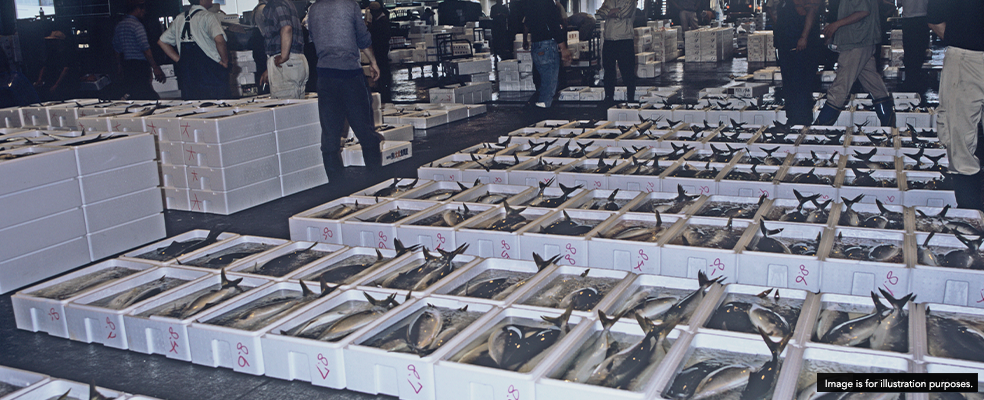
Early morningMarkets
Perishable products that are picked or harvested in rural districts are traded in markets.
They are packaged appropriately for air transport and brought to the cargo area in the airport.
09:30Acceptance
We accept cargo from customers in the airport cargo area. We check for any discrepancies between the documented and actual quantity and commodity, and whether packaging is appropriate for air transport, among other things. We carefully check directly with the customer so that they can put their confidence in us and feel reassured.
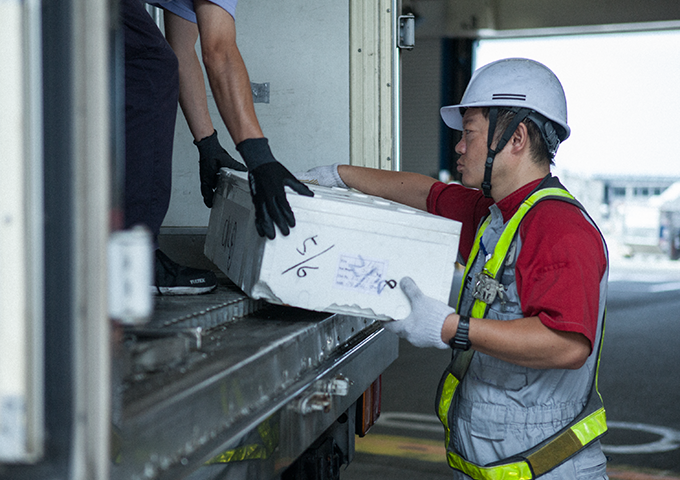
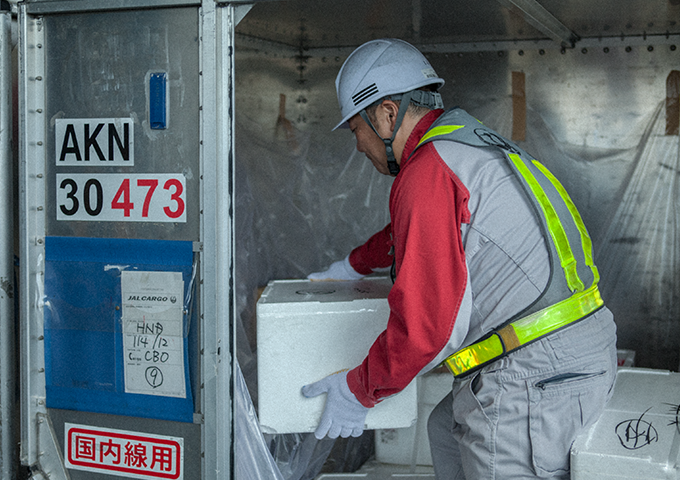
09:40Build-up
After cargo is accepted, it is loaded in containers for loading into aircraft. We handle cargo with care so that it reaches the destination in the same condition as when the customer entrusted it to us. To ensure safe transport, we take necessary measures according to cargo features, such as spreading plastic sheets to prevent water leakage from perishables or tying down heavy cargo with ropes.
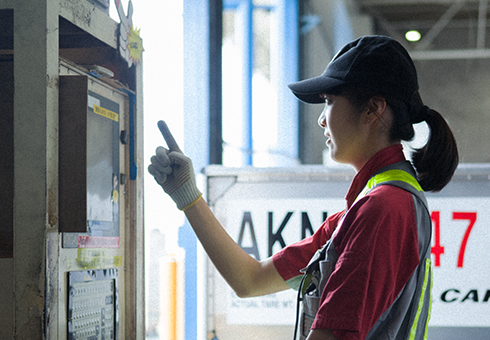
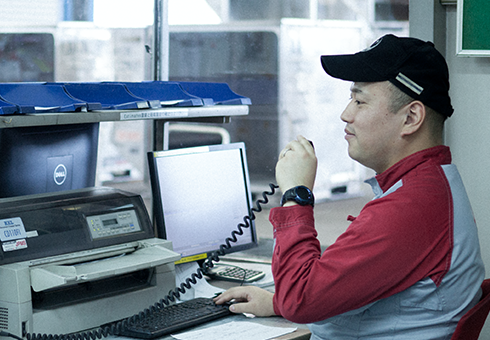
10:00Register in cargo system
Containers loaded with cargo are weighed on cargo scales and the weight is registered in the system. Incorrect registration of the container number, weight, commodity or other data could jeopardize safety in operations. Furthermore, the data are required for creating a Load Instruction Sheet, so it must be registered correctly and also speedily.
10:30Create Load Instruction Sheet/
Load Control
To keep aircraft weight and the center of gravity within specified limits, we decide the weight and loading positions of items to be loaded in the cargo compartment and create a Load Instruction Sheet. JAL Group flights operating around the world are centrally controlled at Tokyo Head Office based on information sent from each airport.
Maximum aircraft weight including passengers, cargo, and fuel is specified by aircraft type. When it is expected that more cargo can be loaded, such as when passenger count is less than the forecast, we quickly take action such as notifying the relevant airport and carefully controlling weight so that as much cargo can be loaded as possible.

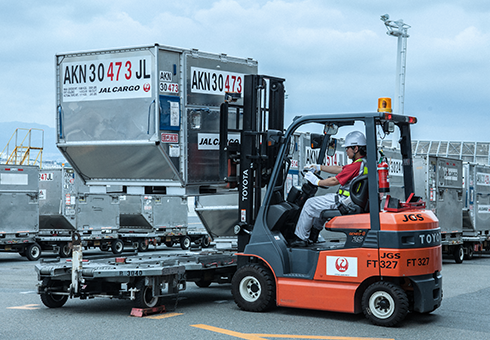
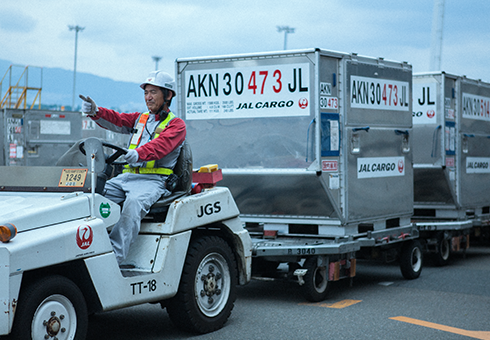
10:45Delivery
from parking spot
to domestic cargo area
The unloaded containers are delivered to the cargo area. The driver pays attention while driving to minimize shocks during delivery.
11:00Loading
The containers are loaded in specified positions inside the cargo compartment according to the Load Instruction Sheet created by the Load Control section. They are restrained by locks so that they do not move during takeoff, landing and in flight. We work with speed to avoid any departure delays, while checking each step in the process by pointing and calling out loud in order to maintain flight safety.
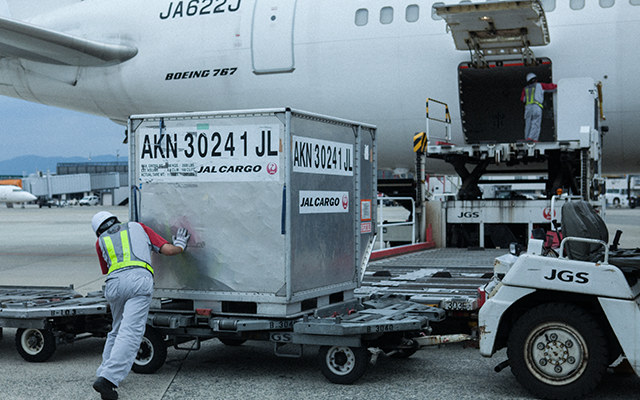
SCENE 03
International air cargo ~from Haneda to the world~
Seamless transport quality
connecting Japan and the world
- Unloading
- Build-up
- Delivery
- Arrival check
- Load
Control
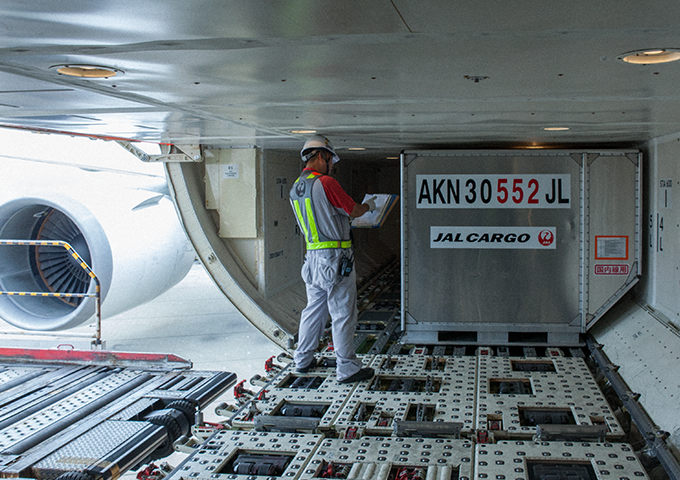
12:30Unloading
After the aircraft reaches its parking spot after arriving at Haneda Airport from Itami Airport, the containers are unloaded and transferred to dollies, which are towed by trucks. Containers loaded with passenger baggage are loaded in the cargo compartment, but their destinations are different. Therefore, staff check loading information in advance, and maintain effective teamwork.
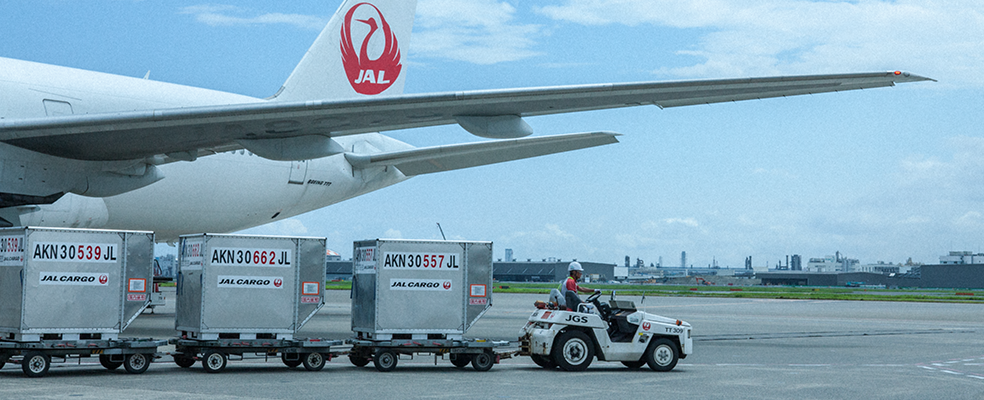
13:00Delivery
from parking spot
to domestic cargo area
The unloaded containers are delivered to the cargo area. The driver pays attention while driving to minimize shocks during delivery.
13:30Check arrival cargo
The containers are then sorted into cargo to be delivered to customers and cargo to be transferred to international flights. As large volumes of cargo arrive from airports across Japan, we check information in advance so that sorting goes smoothly. As for cargo to be transferred to international flights, we check conditions inside containers and then give instructions to deliver them to the international cargo area. Each container clearly shows where it should be delivered so that the driver does not make mistakes.
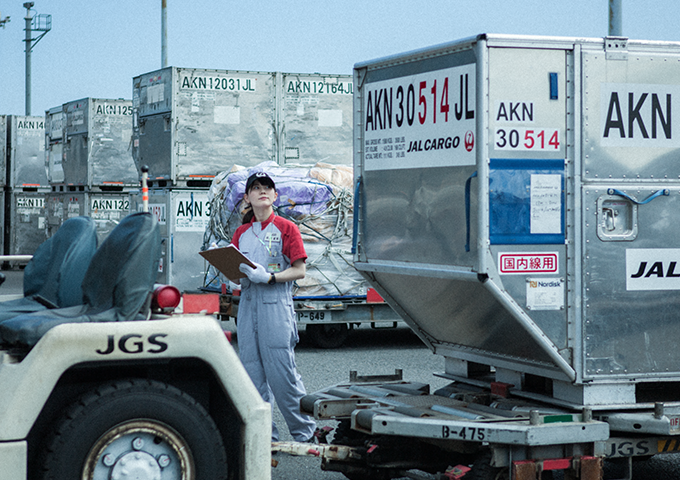
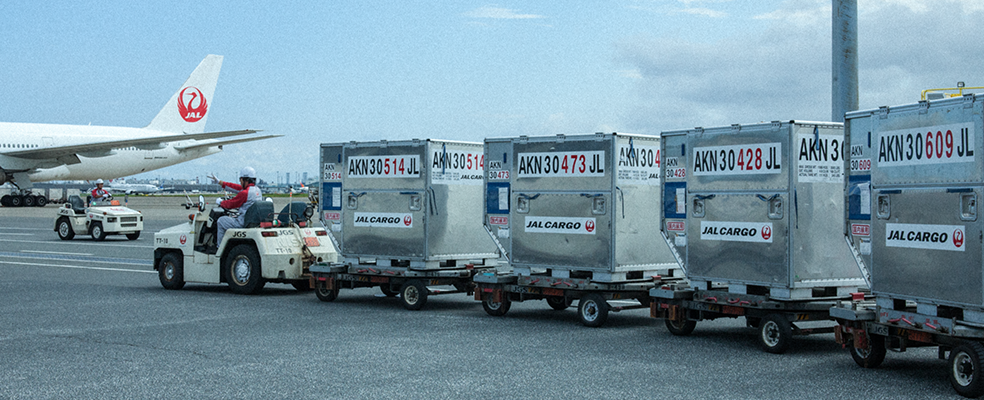
14:00Delivery
from domestic cargo area
to international cargo area
The containers are delivered to the international cargo area. As it might be located far away, they must be delivered speedily, but the driver puts top priority on safety so that cargo inside the containers is not damaged by toppling over. When giving the containers to staff in the international cargo area, the driver reports cargo conditions as well, instead of merely delivering them.
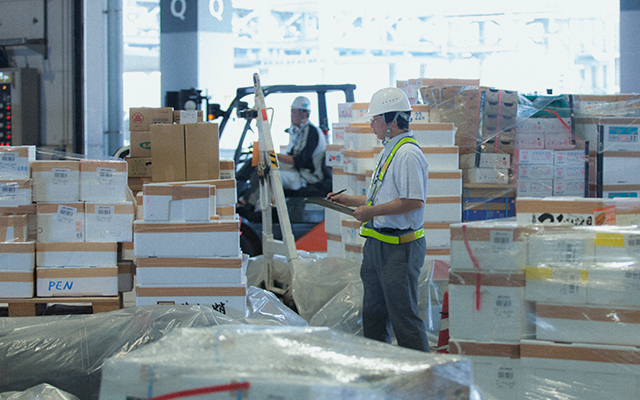
18:00Build-up
The international cargo area at Haneda Airport is congested with cargo collected from all parts of Japan and a tremendous number of cargo pieces from domestic and overseas airports to be transferred. The items are varied such as perishables, precision machines and pharmaceuticals, and come in all sizes. Panel-shaped loading equipment called pallets are used as well as box-shaped containers to suit the features of cargo.
23:00Create Load Instruction Sheet/
Load Control
As JAL Group flights operating worldwide are centrally controlled at Tokyo Head Office, Load Instruction Sheets are created 24 hours a day. In late night hours, several flights are handled simultaneously, primarily flights arriving from Europe and North America. Therefore, we work meticulously. For example, we create instructions to load cargo and mail that need to be delivered quickly after arrival in positions where they can be easily unloaded.
The heavier aircraft weight is at takeoff, the more fuel is consumed. In case cargo weight increases right before departure, additional fuel has to be loaded, and this would affect on-time operations. As flight time of international flights is long, the amount of fuel required will change significantly if weight is revised. Therefore, we bear in mind to forecast weight accurately through prior coordination with each airport.

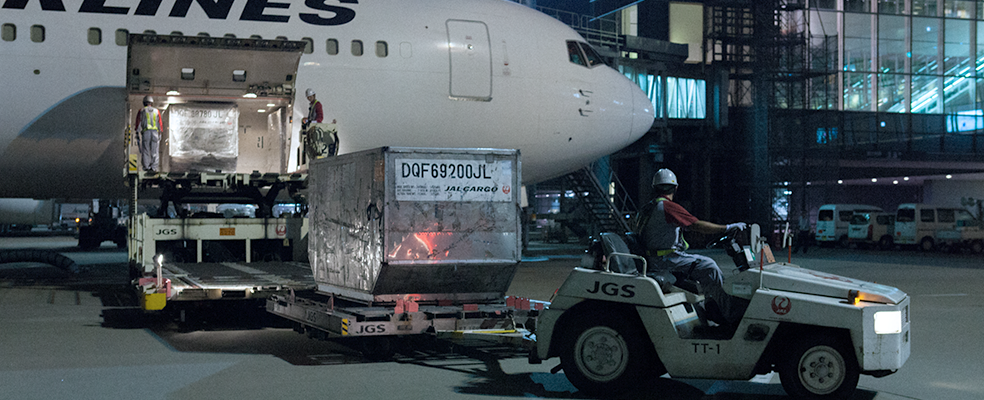
Delivery
from international cargo area
to parking spot
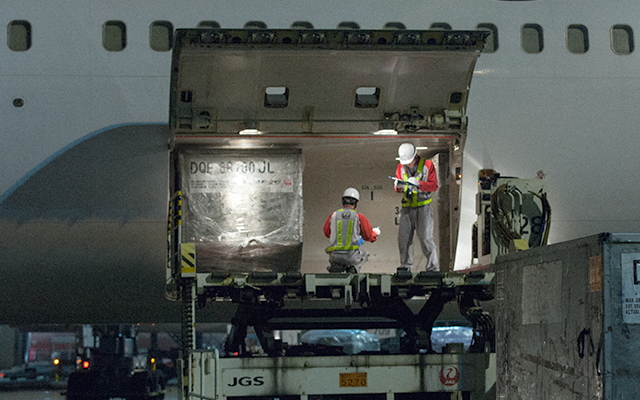
23:30Loading
When loading and unloading cargo late at night, workers check more carefully than usual and use greater caution as visibility is poor.
As towing trucks and ground handling equipment are moving around the aircraft, they watch out for each other's safety by giving signs with bigger gestures and louder voices than in the daytime.
00:05Departure
After loading is completed, it's time for departure.
We see off the aircraft with gratitude. "Thank you for choosing JAL. Have a safe journey."
When we see passengers smiling or waving to us from the window as the aircraft leaves the spot, we feel a sense of accomplishment and relief.
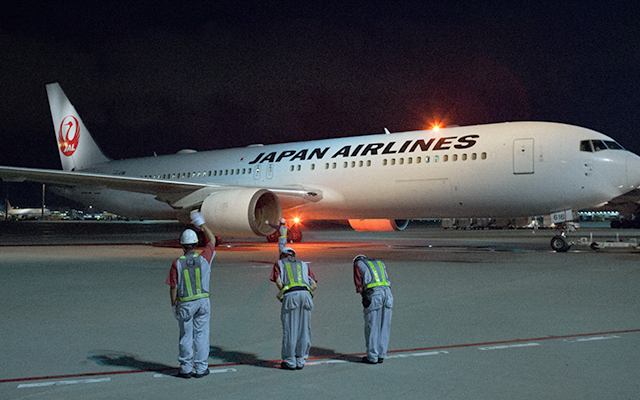
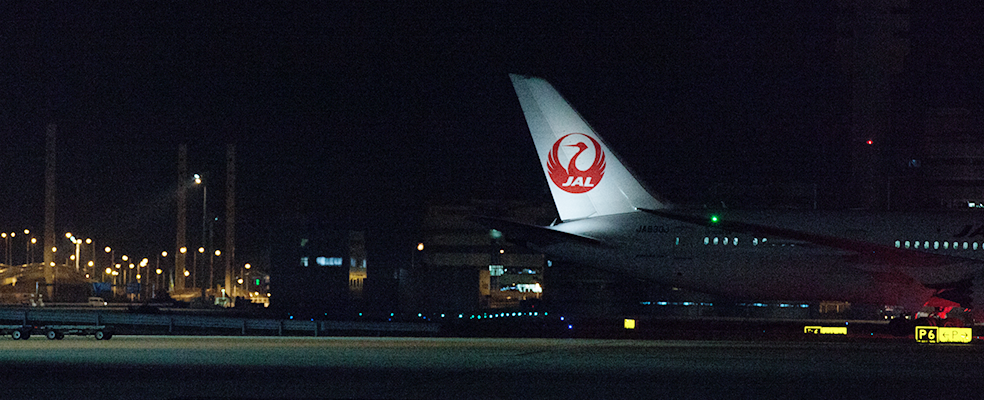
Take off
Next DayTo customers
Through speedy delivery service with air transportation, the perishable products are still fresh when they reach the dinner table of customers around the world.
